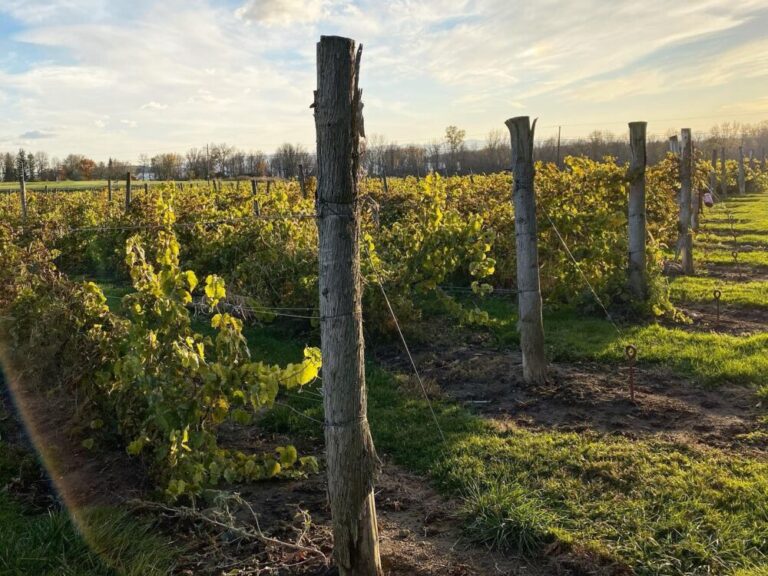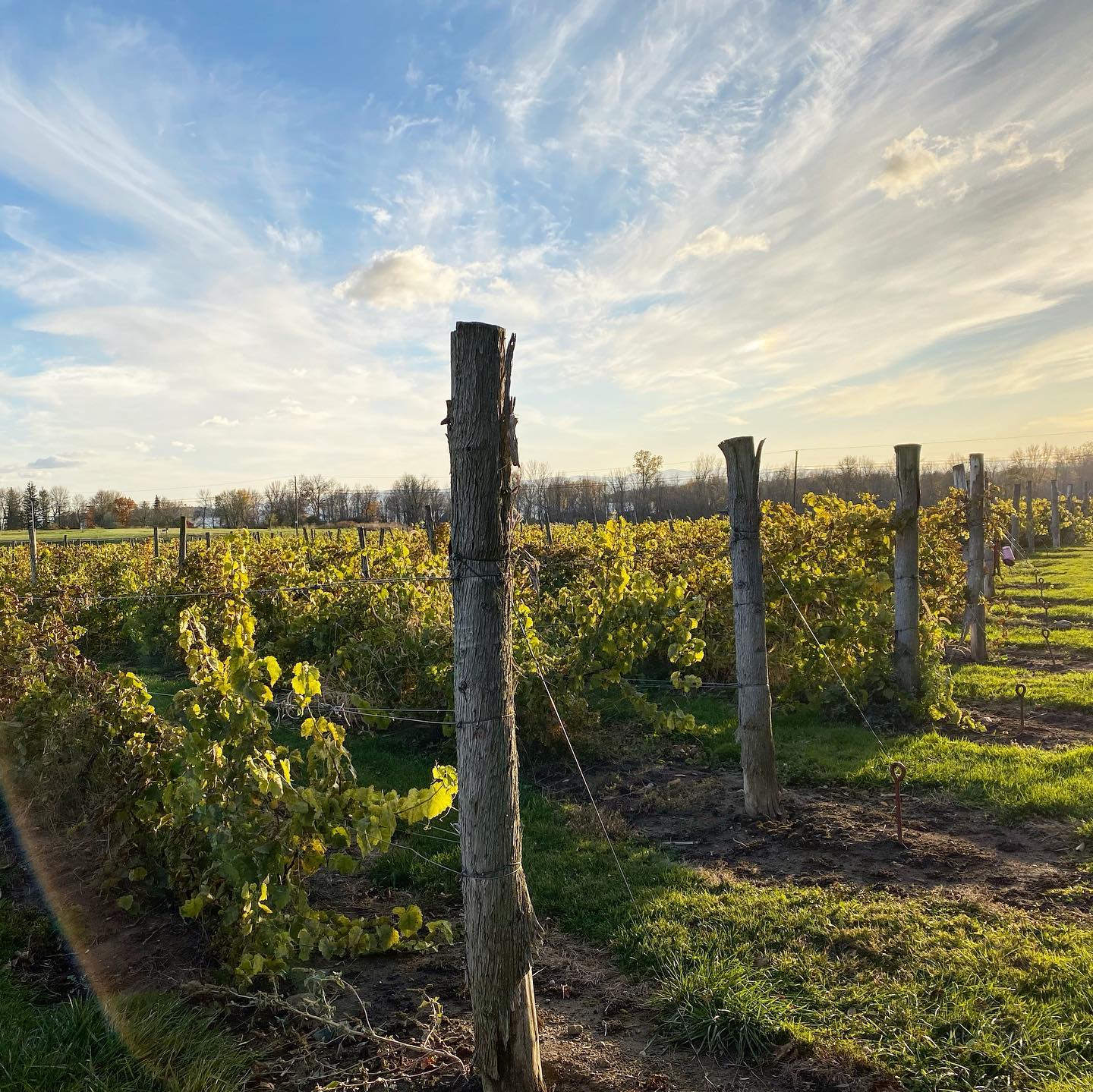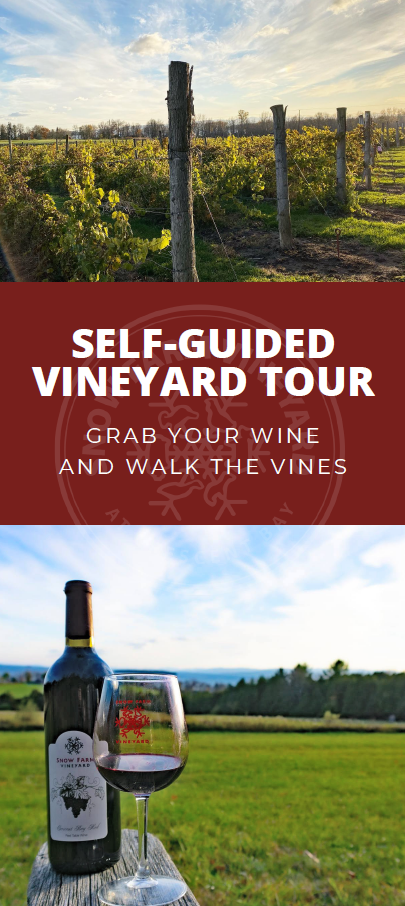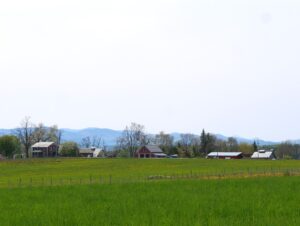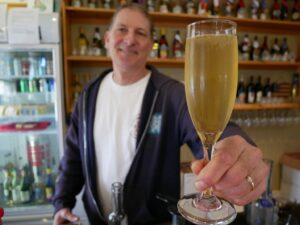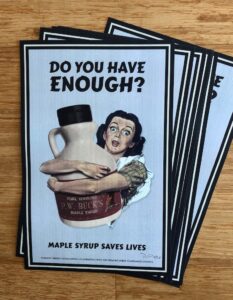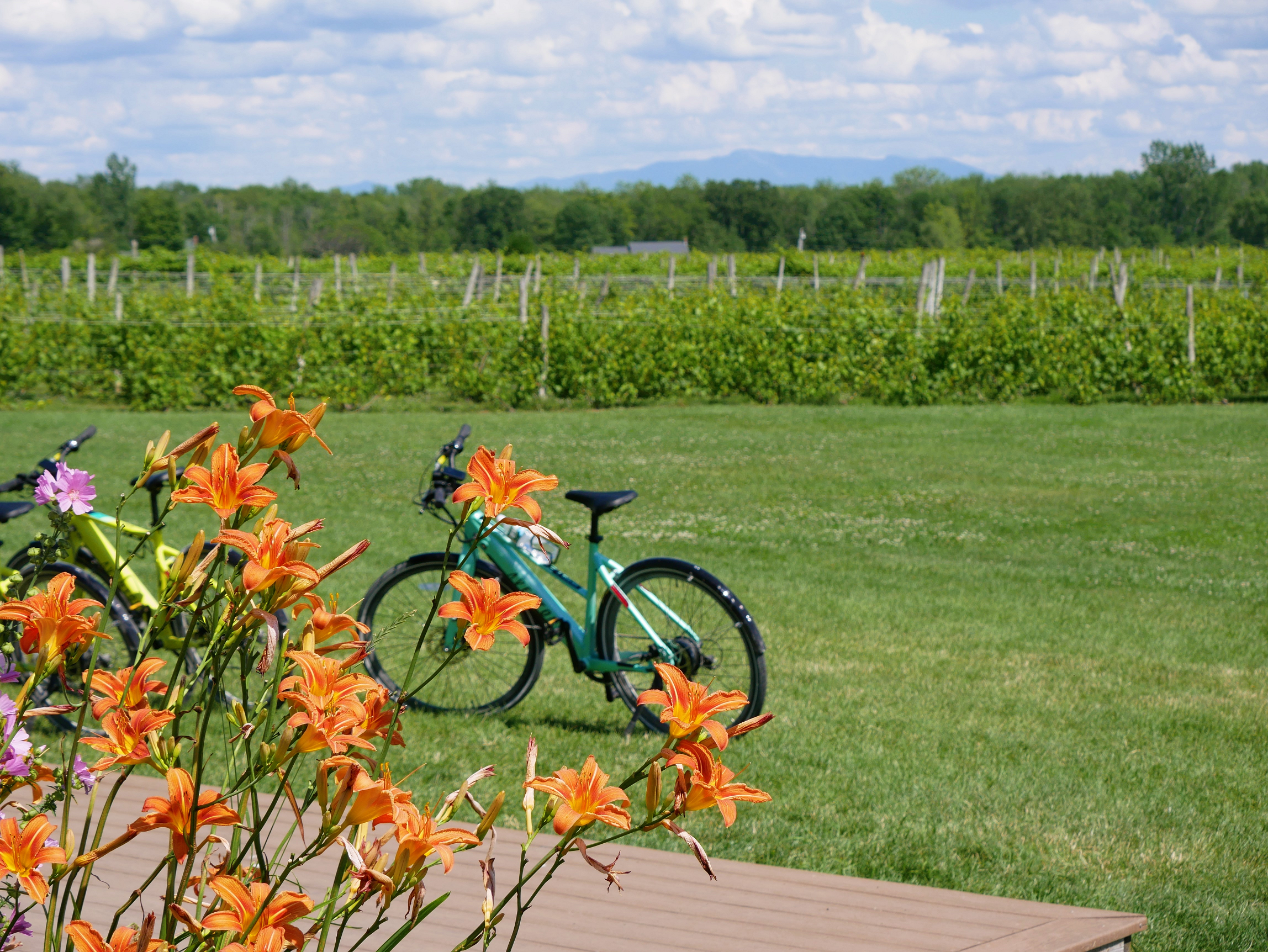Explore over 13 acres of grapevines, enjoy the outdoors, and discover a deeper connection to Vermont wine with our self-guided vineyard walking tour!
You’ll enjoy expansive views of the mountains and Lake Champlain, with over 120 acres of preserved farmland as the backdrop surrounding the vineyard.
Vineyard Tour: Explore 9 of Our Grape Varietals!
This self-guided vineyard walking tour is fairly flat, an easy walk, and at an average pace will take you about 30 minutes. You can download our handy walking tour guide printable PDF below.
Grab a glass of wine from the tasting room, and let’s go!
Begin the vineyard walking tour at the first row of Vignoles grapes located closest to the winery and tasting room, and follow the route below. Each section of grapes is marked with a wooden sign with the varietal name on it.
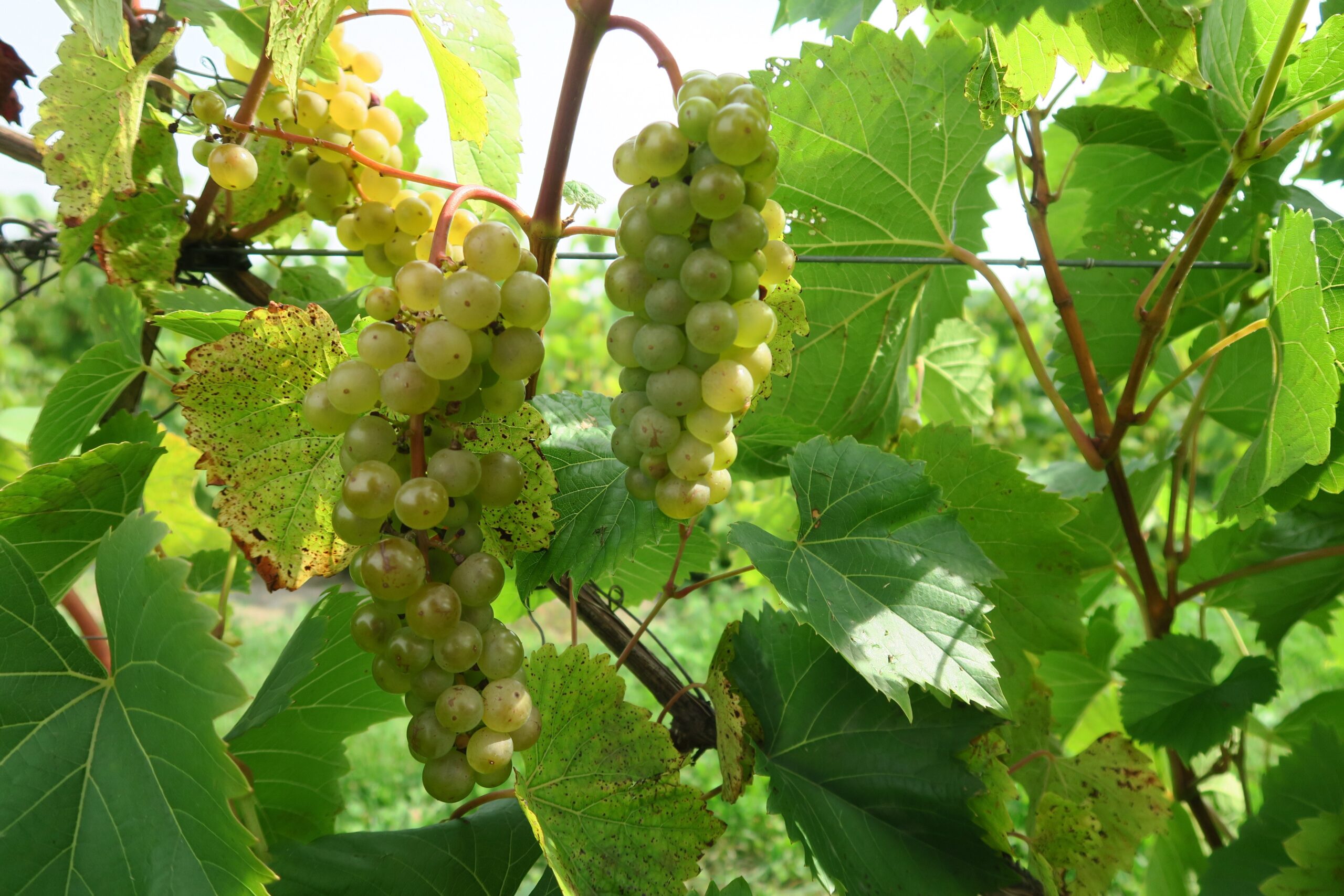
Stop 1 of 9: Vignoles
Types of Wine We Make: Late Harvest Vignoles and Vignoles table wine (not available every year).
Ripening Date: Late September to Early October
Planting Date: 1997, 10 rows
Origin: Vignoles is a hybrid white grape developed in France by J.F. Ravat in 1930 and was originally named Ravat 51. It is a cross of Seibal and Pinot Noir grapes.
Fun fact: Some grapes have a harmless fungus on them called Botrytis cinerea. It causes the sugars to concentrate and sweetens the grapes because it’s a spore that sucks out the water, dehydrating them. That, and being harvested late in the season, is what makes our Late Harvest Vignoles dessert wine.
Stop 2 of 9: Vidal Blanc
Types of Wine We Make: Ice Wine and Vidal Blanc (dry white wine)
Ripening Date: Late October for white wine and December for ice wine
Planting Date: 1997, 10 rows
Origin: Vidal Blanc is a hybrid white grape developed in France by crossing Seibel 5656 and Rayon d’Or grapes. It was first brought to the U.S. in the 1950s.
Fun Fact: French hybrid grapes were developed to be resistant to phylloxera (a grapevine pest) and the cold. Yet, European winemakers noticed the quality wasn’t the same as the original vinifera varieties and weren’t huge fans. So, they brought them to the U.S. to see how they would do here. Had French hybrid grape varieties not been brought to the U.S., where they now thrive, they would probably have been forgotten!
Today, Vidal Blanc is one of our vineyard gems because it makes our popular and rare ice wine, which is made when grapes are plucked frozen from the vine after the sugar has concentrated.
Stop 3 of 9: Léon Millot
Types of Wine We Make: Léon Millot, Leon Millot Reserve, and Crescent Bay Red
Ripening Date: Early September
Planting Date: 1997, 9 rows; 2002, 4 partial rows in the Seyval field
Origin: Léon Millot is a French hybrid red grape developed in 1911 by crossing the Goldriesling grape with another North American hybrid. It was named after the winemaker and tree nursery owner Léon Millot.
Fun Fact: It’s pronounced lay-on-me-oh. It produces smaller grape clusters than other varieties and has to be encouraged to be bushy to create more buds. Léon Millot is early ripening and is usually the first varietal we harvest in the fall. It creates a light to medium-bodied red wine with a very deep color and low tannins, making it easy to drink.
Stop 4 of 9: Riesling
Types of Wine We Make: Riesling
Ripening Date: Late October
Planting Date: 1997, 8 rows
Origin: Riesling is of the Vitis vinifera species from Europe and is an ancient purebred white grape variety. It is popular in Germany, France, and the Northern U.S.
Fun Fact: Riesling is extremely cold-sensitive and difficult to grow in Vermont. Production drops during really cold winters, yet we’ve been persistent and have been growing it since 1997! We take our chances and leave the vines uncovered in the winter to keep the voles from making their homes in the vines. At Snow Farm we make a dry to semi-dry style of Riesling.
*Side Stop: Check out our 6 rows of Vidal Blanc that were planted here in 2008 as an addition to the vineyard! Notice how much smaller the vines are due to the fact that deer love to munch on this section of the vines.
Stop 5 of 9: Frontenac White
Types of Wine We Make: A new chardonnay-style wine is coming soon!
Ripening Date: Early October
Planting Date: 2019, 6 rows
Origin: Frontenac White is a white grape cultivated at the University of Minnesota. It grew naturally from mutations from the Frontenac red grape. Winemakers noticed branches growing off the Frontenac red that produced gray grapes with white juice instead of red. Pinot Noir was created in the same way with natural mutations that created the white grapes, Pinot Gris and Pinot Blanc.
Fun Fact: Our Frontenac White grapes replaced the Pinot Noir grapes we were growing here that didn’t like the cold. We currently have over 15 varieties of grapes and are always experimenting to see which varieties will grow best in our climate.
Stop 6 of 9: Seyval Blanc
Types of Wine We Make: Seyval Blanc, Snow White, Fox Hill Maple, and Pet Nat
Ripening Date: Late September
Planting Date: 1997, 24 rows
Origin: Seyval Blanc is a French hybrid grape that is now popular in the Northeastern U.S and Quebec for being cold-hardy. For two decades, as the wine industry was developing in Quebec, over 50 percent of the grapes grown there were Seyval Blanc.
Fun Fact: With 24 rows planted, this grape is clearly our winemaker’s favorite. Mainly for its versatility and big grape clusters, making it easy to pick. It can be used on its own, as a blend, or for sparkling wine.
Stop 7 of 9: Frontenac Gris
Types of Wine We Make: Rosé
Ripening Date: Late September to Early October
Planting Date: 2017, 16 rows
Origin: Frontenac Gris is a white grape cultivated by the University of Minnesota in 2003. Like the Frontenac White, Frontenac Gris is a white wine version of Frontenac Red, introduced in 2003. It started as a natural mutation of Frontenac Red, yielding gray fruit and white juice. The word ‘gray’ is ‘gris’ in French, hence Frontenac Gris!
Fun Fact: Our Rosé is one of our most popular wines and sells out every year. The skin of the grape is a little bit dark so when it’s macerated with the juice it adds the pink color you get with Rosé. We also soak Aronia berries into the wine for a few weeks. It creates beautiful and long-lasting colors with complex flavors of strawberry and raspberry through the fermentation process.
Stop 8 of 9: Baco Noir
Types of Wine We Make: Rose Red and Baco Noir
Planting Date: 1999, 33 rows
Ripen Date: Mid-September
Origin: Baco Noir is a first-generation French hybrid cross of an old-world Vinifera, Folle Blanche (a variety found in the Loire region in France) with a Riparia vine that grows wild in the Northern U.S.
Fun Fact: With 33 rows planted and it’s large production, Baco Noir is our biggest red wine producer. The land the grapes are growing on has proudly been used for agriculture for over 200 years. What began as a dairy farm transformed into a vineyard as a dream to keep the land from being developed. See if you can spot the remnants of cow fencing in the fields!
Stop 9 of 9: Cayuga
Types of Wine We Make: Snow White and Crescent Bay White
Planting Date: 1999, 15 rows
Ripening Date: Late September
Origin: Cayuga white wine grape is an American hybrid that was developed by crossing the Vitis labrusca hybrids Schuyler and Seyval Blanc at Cornell University.
Fun Fact: It was named after Cayuga Lake in the Finger Lakes region of New York, where it was first bred and grown at vineyards on the shores of the lake.
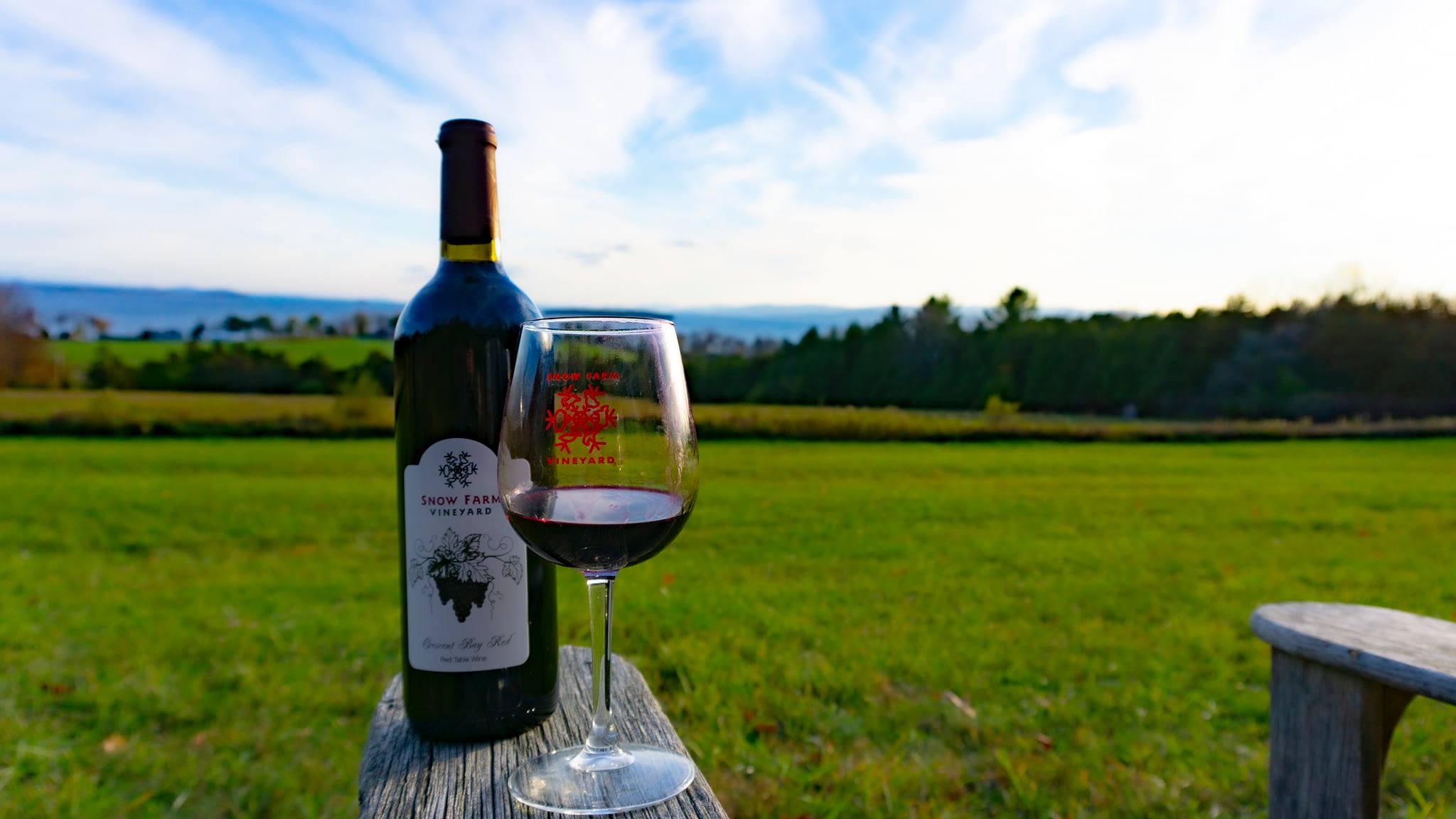
Stop 10 Bonus: Hike Fox Hill for Unbeatable Views!
Just after the start of the Seyval Blanc rows, a road opens up to the left through the cedar trees. Walk up into the clearing and continue along the woodline until you reach the top (10-15 minute walk).
Take in the views of Lake Champlain and the Local Motion Island Line Bike Path. There are a few benches and tables to set your wine on to take photos.
We hope you enjoyed your self-guided vineyard tour! You’re sure to impress your family and friends with your new Vermont wine knowledge.
